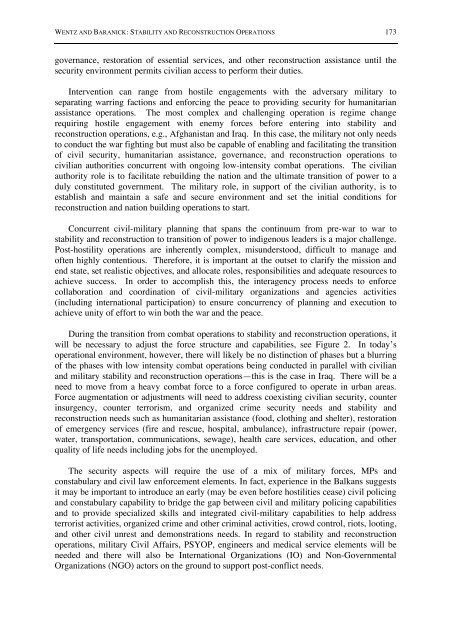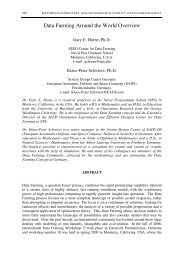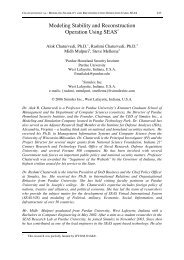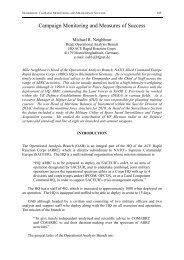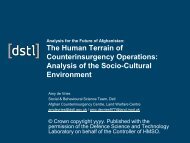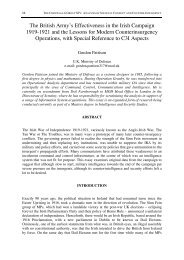Stability and Reconstruction Operations: What ... - Cornwallis Group
Stability and Reconstruction Operations: What ... - Cornwallis Group
Stability and Reconstruction Operations: What ... - Cornwallis Group
You also want an ePaper? Increase the reach of your titles
YUMPU automatically turns print PDFs into web optimized ePapers that Google loves.
WENTZ AND BARANICK: STABILITY AND RECONSTRUCTION OPERATIONS 173<br />
governance, restoration of essential services, <strong>and</strong> other reconstruction assistance until the<br />
security environment permits civilian access to perform their duties.<br />
Intervention can range from hostile engagements with the adversary military to<br />
separating warring factions <strong>and</strong> enforcing the peace to providing security for humanitarian<br />
assistance operations. The most complex <strong>and</strong> challenging operation is regime change<br />
requiring hostile engagement with enemy forces before entering into stability <strong>and</strong><br />
reconstruction operations, e.g., Afghanistan <strong>and</strong> Iraq. In this case, the military not only needs<br />
to conduct the war fighting but must also be capable of enabling <strong>and</strong> facilitating the transition<br />
of civil security, humanitarian assistance, governance, <strong>and</strong> reconstruction operations to<br />
civilian authorities concurrent with ongoing low-intensity combat operations. The civilian<br />
authority role is to facilitate rebuilding the nation <strong>and</strong> the ultimate transition of power to a<br />
duly constituted government. The military role, in support of the civilian authority, is to<br />
establish <strong>and</strong> maintain a safe <strong>and</strong> secure environment <strong>and</strong> set the initial conditions for<br />
reconstruction <strong>and</strong> nation building operations to start.<br />
Concurrent civil-military planning that spans the continuum from pre-war to war to<br />
stability <strong>and</strong> reconstruction to transition of power to indigenous leaders is a major challenge.<br />
Post-hostility operations are inherently complex, misunderstood, difficult to manage <strong>and</strong><br />
often highly contentious. Therefore, it is important at the outset to clarify the mission <strong>and</strong><br />
end state, set realistic objectives, <strong>and</strong> allocate roles, responsibilities <strong>and</strong> adequate resources to<br />
achieve success. In order to accomplish this, the interagency process needs to enforce<br />
collaboration <strong>and</strong> coordination of civil-military organizations <strong>and</strong> agencies activities<br />
(including international participation) to ensure concurrency of planning <strong>and</strong> execution to<br />
achieve unity of effort to win both the war <strong>and</strong> the peace.<br />
During the transition from combat operations to stability <strong>and</strong> reconstruction operations, it<br />
will be necessary to adjust the force structure <strong>and</strong> capabilities, see Figure 2. In today’s<br />
operational environment, however, there will likely be no distinction of phases but a blurring<br />
of the phases with low intensity combat operations being conducted in parallel with civilian<br />
<strong>and</strong> military stability <strong>and</strong> reconstruction operations—this is the case in Iraq. There will be a<br />
need to move from a heavy combat force to a force configured to operate in urban areas.<br />
Force augmentation or adjustments will need to address coexisting civilian security, counter<br />
insurgency, counter terrorism, <strong>and</strong> organized crime security needs <strong>and</strong> stability <strong>and</strong><br />
reconstruction needs such as humanitarian assistance (food, clothing <strong>and</strong> shelter), restoration<br />
of emergency services (fire <strong>and</strong> rescue, hospital, ambulance), infrastructure repair (power,<br />
water, transportation, communications, sewage), health care services, education, <strong>and</strong> other<br />
quality of life needs including jobs for the unemployed.<br />
The security aspects will require the use of a mix of military forces, MPs <strong>and</strong><br />
constabulary <strong>and</strong> civil law enforcement elements. In fact, experience in the Balkans suggests<br />
it may be important to introduce an early (may be even before hostilities cease) civil policing<br />
<strong>and</strong> constabulary capability to bridge the gap between civil <strong>and</strong> military policing capabilities<br />
<strong>and</strong> to provide specialized skills <strong>and</strong> integrated civil-military capabilities to help address<br />
terrorist activities, organized crime <strong>and</strong> other criminal activities, crowd control, riots, looting,<br />
<strong>and</strong> other civil unrest <strong>and</strong> demonstrations needs. In regard to stability <strong>and</strong> reconstruction<br />
operations, military Civil Affairs, PSYOP, engineers <strong>and</strong> medical service elements will be<br />
needed <strong>and</strong> there will also be International Organizations (IO) <strong>and</strong> Non-Governmental<br />
Organizations (NGO) actors on the ground to support post-conflict needs.


